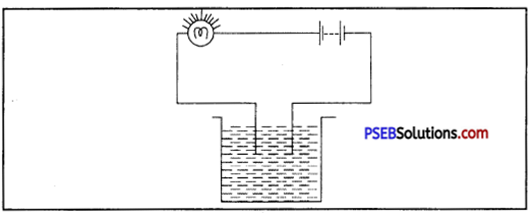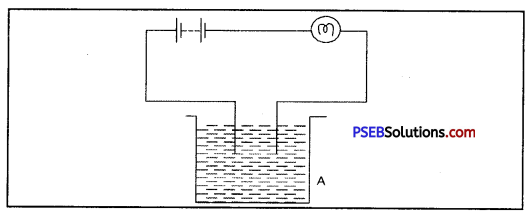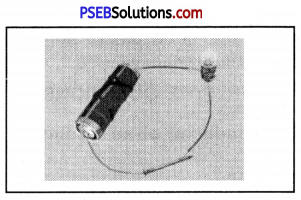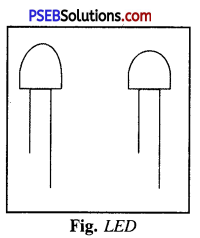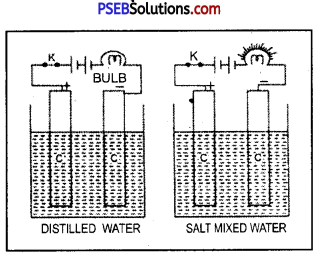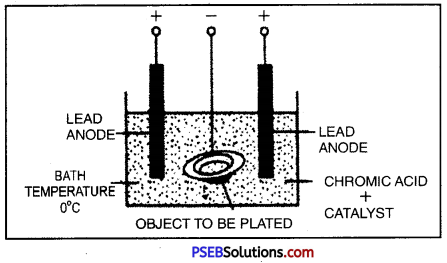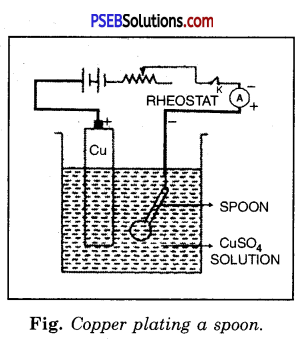Punjab State Board PSEB 8th Class Science Book Solutions Chapter 15 Some Natural Phenomena Textbook Exercise Questions and Answers.
PSEB Solutions for Class 8 Science Chapter 15 Some Natural Phenomena
PSEB 8th Class Science Guide Some Natural Phenomena Textbook Questions and Answers
Exercises
Select the correct option in Questions 1 and 2.
Question 1.
Which of following cannot be charged easily by friction?
(a) A plastic scale
(b) A copper rod
(c) An inflated balloon
(d) A woollen cloth.
Answer:
(b) A copper rod.
Question 2.
When a glass rod is rubbed with a piece of silk cloth the rod
(а) and cloth both acquire positive charge.
(b) becomes positively charged while the cloth has a negative charge.
(c) and the cloth both acquire negative charge.
(d) becomes negatively charged while the cloth is positive charged.
Answer:
(b) becomes positively charged while the cloth has a negative charge.
![]()
Question 3.
Write T against true and F against false in the following statements.
[а] like charges attract each other.
Answer:
False
[b] A charged glass rod attracts a charged plastic straw.
Answer:
True
[c] Lightning conductor cannot protect a building from lightning.
Answer:
False
[d] Earthquakes can be predicted in advance.
Answer:
False
Question 4.
Sometimes, a crackling sound is heard while taking off sweater during winters. Explain.
Answer:
Woollen clothes get electrically charged when they get rubbed. Due to rubbing attraction or repulsion occurs between their loose particles which results in crackling sound.
Question 5.
Explain why a charged body loses its charge if we touch it with our hand.
Answer:
Human body is a conductor of electricity. When a body is touched with hand, the electric current of body passes to the earth through human body and body loses its charges.
Question 6.
Name the scale on which the destructive energy of an earthquakes is measured. An earthquake measures 3 on this scale. Would it be recorded by a seismograph ? Is it likely to cause much damage ?
Answer:
Scale used to measure earthquake is Richter scale.
Earthquake with measure 3 can be recorded on seismograph but this earthquake is very feeble in its intensity and very less destructive.
Question 7.
Suggest three measures to protect ourselves from Lightning.
Or
Suggest any two safety measures that we should take to prevent damage caused by linghtning.
Answer:
Measures of Protection:
- On hearing thunder, go inside closed areas such as houses, buildings etc.
- In bus, close all the doors and windows.
- In open, sit on floor with your head in knees and arms.
Question 8.
Explain why a charged balloon is repelled by an other charged balloon whereas an uncharged balloon is attracted by another charged balloon ?
Answer:
Same materials get same charges on rubbing and same charges repel each other.
Therefore, balloon on rubbing are similarly charged and thus repel each other while a charged and an uncharged balloon attract each other.
![]()
Question 9.
Describe with the help of a diagram an instrument which can be used to detect a charged body.
Answer:
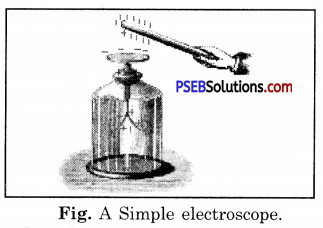
Electroscope is used to detect electric charges or kind of charge on a body.
To make an electroscope, take a glass jar. Cover it with a wooden or cardboard disc fixed with an aluminium foil on a paper clip in the vertical position.
Question 10.
List three states in India where earthquake are more likely to strike.
Answer:
States of India, highly susceptible to earthquake:
- Rann of Kutch
- Rajasthan
- Highlands of Sind-Ganga
- Kashmir.
Question 11.
Suppose you are outside your home and an earthquake strikes. What precaution would you take to protect yourself ?
Answer:
Protection against earthquake outside the house.
- Lie down in open far from buildings, trees and electric wires.
- Do not step out from car or bus.
- Take car or bus towards open areas.
Question 12.
The weather department has predicted that a thunderstorm is likely to occur on a certain day. Suppose you have to go out on that day. Would you carry an umbrella ? Explain.
Answer:
To go out during thunderstorm is not safe and with umbrella it is fatal because high buildings, electric wires, black materials etc. all attract thunderstorm. So, it is advisable to stay away from them.
PSEB Solutions for Class 8 Science Some Natural Phenomena Important Questions and Answers
Multiple Choice Questions
Question 1.
How many kinds of electric charge are there ?
(a) 2
(b) 3
(c) 4
(d) 6.
Answer:
(a) 2.
Question 2.
The device used for testing electric charge is called:
(a) Electroscope
(b) Microscope
(c) Periscope
(d) Electroplating.
Answer:
(a) Electroscope.
![]()
Question 3.
What is the measure of earthquake on Rictor scale that can cause devastation ?
(a) Less than 5
(b) Between 5 and 7
(c) Between 1 and 5
(d) More than 7.
Answer:
(d) More than 7.
Question 4.
Opposite charges ………………. each other.
(а) Attract
(b) Repel
(c) Sometime attract sometime repel
(d) Neither attract nor repel.
Answer:
(a) Attract.
Question 5.
The central region of earth is called:
(a) Inner core
(b) Outer core
(c) Mantle
(d) Earth crust.
Answer:
(a) Inner core.
Question 6.
Which is the safest place to take shelter during lightning and thunderstorm ?
(a) Building
(b) Open area
(c) Under the tree
(d) All the above.
Answer:
(a) Building.
Very Short Answer Type Questions
Question 1.
What is amber ?
Answer:
It is a type of resin.
Question 2.
What happens when amber is rubbed for longer time ?
Answer:
A spark is produced.
![]()
Question 3.
Who established that spark and lightning were same thing ?
Answer:
Benjamin Franklin, an American Scientist.
Question 4.
What happens when a plastic scale rubbed with dry hair is brought near pieces of paper ?
Answer:
Scale attracts pieces of paper.
Question 5.
Give few examples of charged objects.
Answer:
- Plastic scale rubbed with hair.
- Plastic refill rubbed with polythene.
- Balloon rubbed with woollen cloth.
Question 6.
What happens when two balloons rubbed with woolen cloth are brought together.
Answer:
They repel each other.
Question 7.
Which type of charges attract each other ?
Answer:
Unlike or opposite charges attract each other.
Question 8.
How many types of charges are there ?
Answer:
Two types of charges-
- negative and
- positive.
Question 9.
Why does a plastic comb rubbed in hair attract small bits of paper ?
Answer:
Because it gets charged.
![]()
Question 10.
What will happen when two clouds with unlike charges approach each other ?
Answer:
Lightning strikes.
Question 11.
Is human body a conductor or an insulator ?
Answer:
A conductor.
Short Answer Type Questions
Question 1.
Why is a balloon filled with air rubbed against hair, sticks to the wall when pressed against it ?
Answer:
Air filled balloon when rubbed against hair gets, charged. The charged balloon then sticks to the wall, when pressed against it. It is because the charged balloon attracts the wall and holds on to it.
Question 2.
Why does the paper strip open up when touched with a charged rod ?
Answer:
When we touch one side of the paper strip with a charged rod, the paper strip opens up. The reason for this is that the two sides of the strip get same type of charge from the charged rod and thus repel each other. With the result, the paper strip opens up (diverges).
Question 3.
Why are we advised not to be under a tree, if we are in the open during a thunderstorm ?
Answer:
A highly charged cloud when comes near the tree can induce a powerful opposite charge on the top of tree. This can cause lightning between the cloud and the earth through the tree. It can damage tree and can cause fire.
Question 4.
Why are tall buildings provided with metallic rods, running from the top of building to the ground ?
Answer:
A highly charged cloud can induce an opposite charge on the pointed ends of the metallic rod. When it passes by the tall building, the similar charge passes to the earth through the metallic rod. The lightning passes to the earth safely, without causing any damage to the building.
![]()
Question 5.
What do you mean when we say that a body is electrically charged or electrified ?
Answer:
A body like plastic comb, pen, etc. when rubbed with another body gets the property of attracting small pieces of paper or a pith ball. Then, such a body is a called electrically charged or electrified.
Question 6.
Write a short note on Tsunami.
Answer:
Tsunami. Tsunami are long and high waves, which rise under sea due to earthquakes. It is usually a high speed wave, which rise in sea. It is also known as harbour wave.
Examples.
- In 1819 on Hawain islands.
- In 2004.
Effects of Tsunami.
- Loss of Lives.
- Loss of Aquatic life.
- Physical damage of human life and property.
- Uprooting of plants on the banks of sea or in coastal regions.
Question 7.
Write down the uses of electroscope.
Answer:
Uses of electroscope:
- Electroscope is used to detect the presence of charge.
- It is used to find the type of charge.
- It is used to compare the charges.
Question 8.
What is electric discharging (lightning) ?
Answer:
Electric discharging (Lighting).
The phenomenon of lightning is caused due to discharge through air. It occurs when the charge accumulated in the clouds exceeds a certain limit. When unlike charged clouds come closer to each other, the charges in air between them move with a great velocity. Due to this, an intense spark of lightning is seen moving in the air. This is known as electric discharging or lightning.
Question 9.
Write two examples of electric discharge which are used to ignite the fuel.
Answer:
Examples of Electric discharges:
- By sparkplug in scooter and car.
- By electric gas lighter used to ignite the gas stove in kitchens.
![]()
Question 10.
What are natural phenomena ?
Answer:
Natural Phenomena.
The phenomena which occur suddenly in nature are called natural phenomena. They cause severe damage to life and property to related areas and environment is also affected with human life.
Examples : Earthquake, landslides, food, drought, cyclones, eruption of volcanoes, tsunami, etc.
Question 11.
What are cyclones ? Write effects and reasons caused by it.
Answer:
Cyclone.
Cyclone is a terrible storm which has a speed more than 119 km per hour.
Reasons.
When sea water evaporates in summer season, it rises up and condenses to form cloud. To get the space of upward moving air, air rushes speedily under it. There forms a cyclic motion nearby a centre or due to difference in temperature and pressure present above the hot sea water, cyclones are produced.
Effects.
Cyclones affect crops, health, ships, etc. Landslides and foods cause severe damage to mankind.
Long Answer Type Questions
Question 1.
Give an experiment to show that when two bodies are rubbed together, they get oppositely charged.
Answer:

Experiment.
Take a plastic scale. Wrap flannel at its one end. Rub this side with another plastic scale. Bring these two scales separately near bits of tissue paper. We observe that both scales show attraction toward the bits of tissue paper. This proves that both the scales get charged on rubbing.
Now suspend one scale from a stand and bring the other close to it. They get attracted. It shows that they have opposite charges. It is because opposite charges attract each other. Thus, we may conclude that when two bodies are rubbed together, they get oppositely charged.
Question 2.
What is lightning ?
Answer:
Lightning.
The phenomenon of lightning is caused due to electric discharge through air. It occurs when the charge accumulated in the clouds exceeds a certain limit. In these conditions, the small region of positive charges in the lower part induces a negative charge on the ground below it. The large force of attraction between the opposite charges becomes sufficient to break down the insulation of air.
Once this happens, the entire positive charge in the lower parts of the clouds passes to the earth through a narrow gap in the air. The huge negative charge gets accumulated in the lower parts of the cloud then passes through this conducting path in a very short time. The air in this narrow gap gets heated by the electrical energy to such a high temperature that it appears as a flash of light, which we see as lightning.
![]()
Question 3.
What safety measures should we take to prevent damage caused by lightning ?
Answer:
Precautions to be taken to provide protection against lightning.
The following precautions should be taken to protect ourselves against lightning:
- We should not stand under trees, when lightning occurs and even during rain, when there are chances of lightning to strike.
- We should put up lightning conductor on our buildings to protect our lives and property from damage.
- We should switch off TV sets during lightning for TV antennas are more prone to lightning strikes.
Question 4.
Discuss the construction and working of a lightning conductor.
Answer:
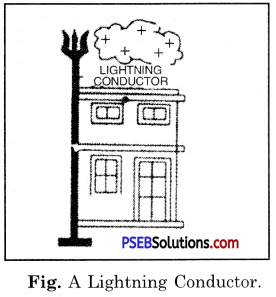
Lightning Conductor.
It is a pointed long metal rod fixed along side of a building. The lower end of this rod is hurried deep under the earth.
Working of a Lightning Conductor.
A lightning conductor protects the building from the destructive effect of the lightning in two ways:
1. During a thunderstorm, a charged cloud passes above the point of the lightning conductor.
If’the cloud is positively charged, it induces a negative charge on its upper end.
This end being pointed cannot retain this charge and sends into the atmosphere a wind on negatively charged particles which cancel some of the positive charge on the clouds. This reduces the potential of the cloud below the spark potential and as such no lightning discharge takes place between the building and the cloud.
2. If a discharge actually takes place, the lightning conductor provides an easy passage to the charge from the cloud to the earth. The building is thus, saved from the destructive effects of the lightning.
Question 5.
What are causes and impacts of earthquake ? Write precautions against earthquake.
Answer:
Earthquake.
Quakes are vibrations created in the earth’s crust. These may arise suddenly.
Reason of earthquake.
Geographically our earth is made up of seven long tectonic plates. These plates move very slowly. But whenever these plates acquire high speeds, there is a disturbance on the earth’s surface. These movements of the earth’s surface cause buildings to fall, bridges, roads, etc. get broken.
Impacts of the earthquake.
Tsunami.
- It is caused by Tsunami (a seismic sea wave)
- Many buildings fall down.
- The supply of basic amenities is disturbed.
- It causes a health hazards.
Precautions against earthquakes:
- In highly seismic areas timber must be used in constructions of buildings instead of heavy materials like mud, stone, brick, etc.
- It is better if the cupboards and shelves are fixed to the walls so that they do not fall easily.
- Be careful where you hang wall clocks, photo-frames, water heaters, etc. so that they do not fall in the event of an earthquake.
- Since some buildings may catch fire due to an earthquake, hence fire fighting equipment should be installed in these buildings.
